SSZT106 january 2022 AWR2944 , LP87745-Q1
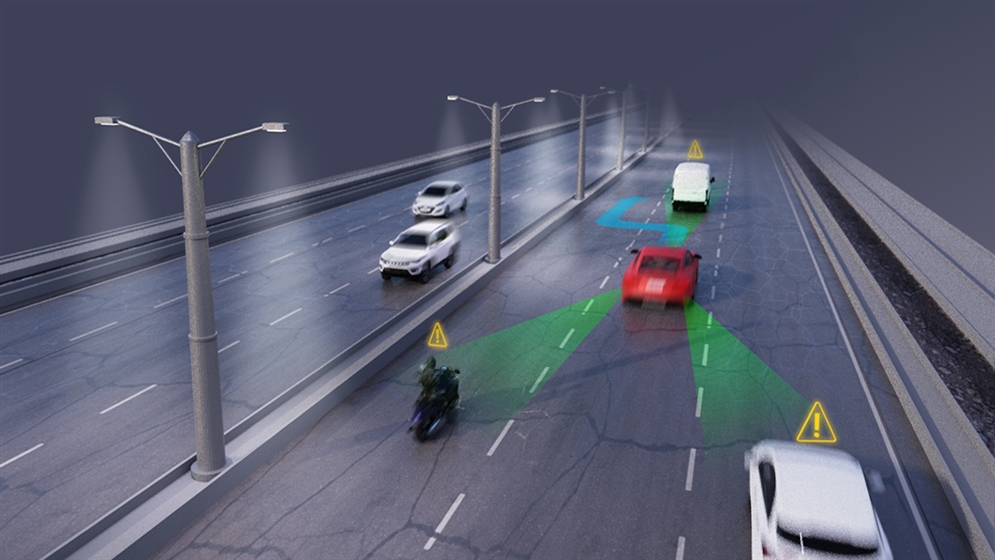
The Euro New Car Assessment Program (NCAP) recently updated their standards for radar to improve driver assistance features in new cars.
NCAP standards vary by region; in the U.S., our NCAP is governed by the National Highway and Traffic Safety Administration a.k.a. NHTSA and the Global NCAP is a centralized organization. However, all organizations have the same goal: to set standards that make cars and driving safer. The organizations provide ratings in the form of 0-5 stars to help consumers make informed new car buying decisions.
In many cases, Euro NCAP has been the first to set standards that raise the bar for the auto industry worldwide. The latest regulation, No. 79, specifies the minimum distance and operation speed for radar in blind-spot detection and lane-change assistance.
For radar, "Minimum distance and minimum operation speed" (section 5.6.4.8) section, helps finding the minimum operation speed Vsmin, down to which the ACSF of Category C is permitted to perform a lane change maneuver, with minimum distance Srear which radar can support.
In other words, it helps to identify how far blind spot detection radar sensor should detect at a minimal operating speed of 20km/h for ACSF of Category C doing LCM.
| Meet corner radar NCAP regulations. | |

|
Watch how TI mmWave radar sensors give automotive customers more tools that can fuel vehicle innovation. |
Making It Safer to Change Lanes
A safe lane change maneuver is one where the approaching vehicle has sufficient time to react (decelerate) to ensure at all time a safe driving distance between the two vehicles. Specifically, the R79 regulation (in section 5.6.4.7) defines a potential lane change maneuver by an ego vehicle as critical if an approaching vehicle in the target lane would have to decelerate at a higher level than 3m/s², 0.4 seconds after the lane change maneuver has started, to ensure the distance between the two vehicles is never less than that the distance the ego vehicle travels in 1 second.
With knowledge of the distance and speed of the approaching vehicle and the speed of the ego vehicle it is possible to calculate the critical distance Scritical (Section 5.6.4.7.1) between the two vehicles at the start of the lane change. A lane change maneuver is not permitted if the distance at the start of the maneuver between the two vehicles is less than Scritical. Figure 1 below plots Scritical as a function of the speed of the ego vehicle. Note that for an ego vehicle speed of 20kmph, the critical distance is close to 180m.
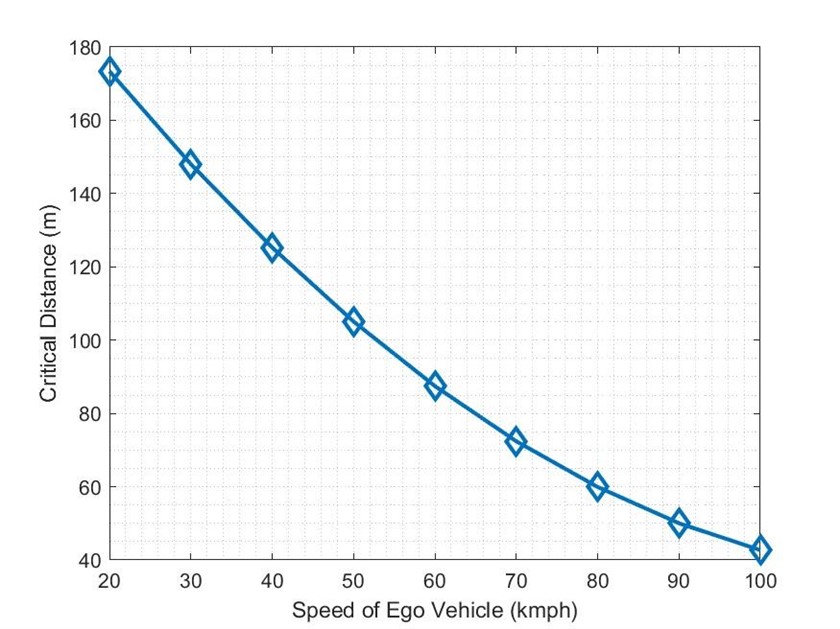 Figure 1 Plotting the distance and
speed needed to make safe critical lane change.
Figure 1 Plotting the distance and
speed needed to make safe critical lane change.Thus, detecting an approaching vehicle and estimating its distance is key to an effective lane change. As described in Section 5.6.4.8 of the regulations, every manufacturer has to declare the minimum distance (Srear) at which the vehicle can reliably detect an approach from the rear in the adjacent lane (the regulations require a two-wheeler to be used for testing Srear). Based on the declared Srear, the regulation then defines a minimum operation speed (Vsmin) which is computed as lowest speed at which the ego-vehicle can perform a lane change, with an approaching vehicle at a distance of Srear and speed of 130 kmph as showing in Figure 2.
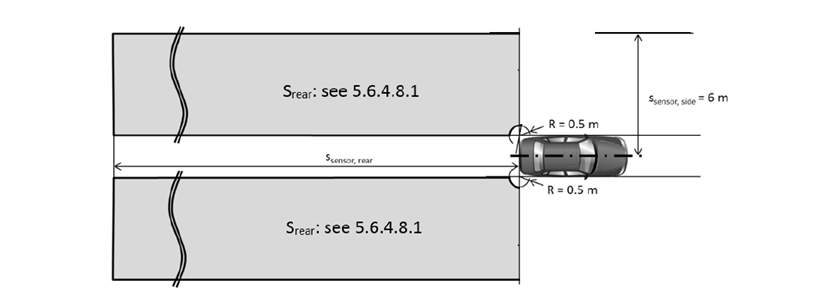 Figure 2 A depicture of NCAP
regulations for speed and distance. (Image source: UN Regulation No.
79)
Figure 2 A depicture of NCAP
regulations for speed and distance. (Image source: UN Regulation No.
79)In the absence of any detection by the ego vehicle of an approaching vehicle in the adjacent lane, the regulations make a worst-case assumption that there is an undetected approaching vehicle at a distance of Srear with a speed of 130kmph. In this circumstance no lane change is permitted at speed below Vsmin. However, should the ego vehicle detect an approaching target at a distance less than Srear, then a lane change can be initiated at a speed less than Vsmin provided the situation is not deemed critical (i.e. the distance between the approaching vehicle and the ego-vehicle is more than Scritical (as defined in 5.6.4.7.1))
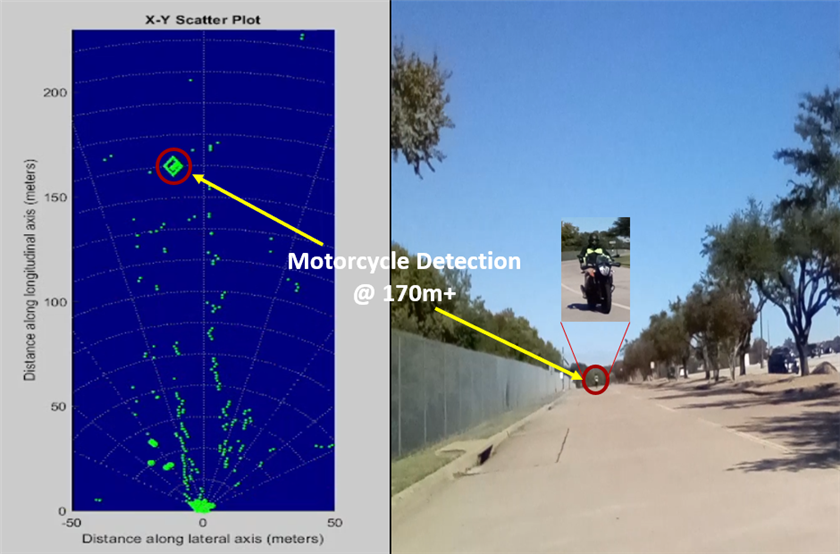 Figure 3 170m+ motorcycle
detection
Figure 3 170m+ motorcycle
detectionTI’s AWR2944 is the first ever single-chip corner radar sensor enabling carmakers to meet these NCAP safety requirements. It provides unmatched corner radar performance with best in class RF performance enabled by a 4th transmitter for 33% higher angular resolution than traditional 3 transmitter devices. Here are the test results with some use case conditions:
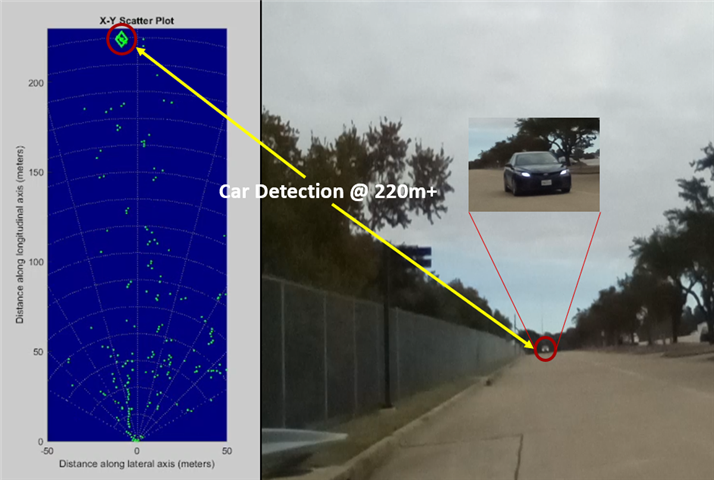 Figure 4 200m+ car detection
Figure 4 200m+ car detectionMeet NCAP Requirements with TI mmWave Radar Sensors for Corner Radar
With longer range, high-resolution radar, cars can sense oncoming vehicles faster with detection at farther distances to more safely change lanes and navigate intersections. By helping automakers meet the latest NCAP safety requirements, TI’s corner radar can make driving safer worldwide.
Additional Resources:
- AWR2944 Product Folder
- High-End Corner Radar Reference Design
- Buy anAWR2944 Evaluation Board
- Order AWR2944 Device Samples
- Power the AWR2944 with the LP87745-Q1 PMIC.